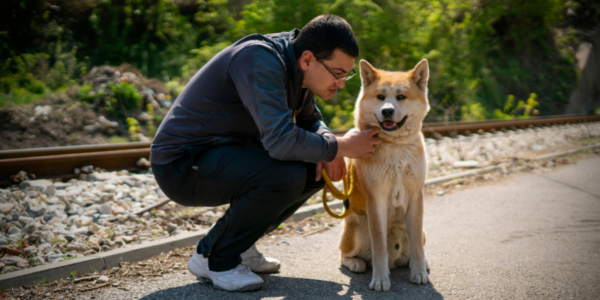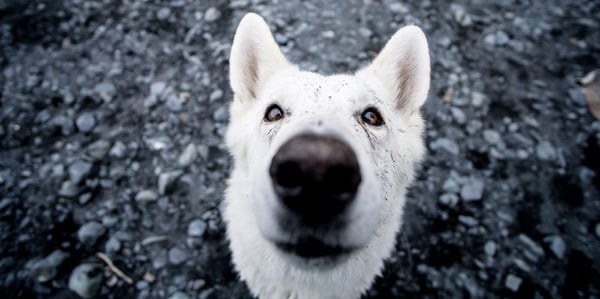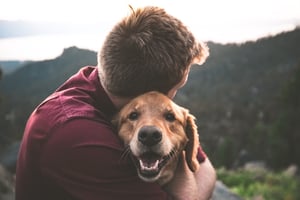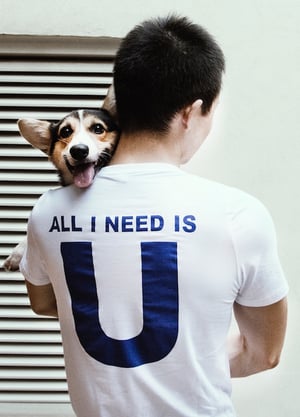 There are a few things that we humans do that can be intimidating to many dogs. We approach dogs the same way we approach other humans: making eye contact, offering an outstretched hand, bending over to get closer.
There are a few things that we humans do that can be intimidating to many dogs. We approach dogs the same way we approach other humans: making eye contact, offering an outstretched hand, bending over to get closer.
These things are often seen as confrontational and overwhelming to most dogs. And we are inadvertently putting ourselves at risk of being bitten.
We also tend to move rather erratically, especially children, which can startle a dog or make them nervous because they don’t know what to expect. People aren’t doing these things on purpose — they’re simply being human.
But dogs aren't humans. And while dogs arguably could be called the best scholars of human behavior considering how long they've cohabitated with us, they still view our actions within their canine framework.
By being aware of how we greet and act around dogs, we can help them feel more at ease and prevent any unfortunate miscommunications between dogs and humans (including dog bites!). Some dogs are naturally more shy and cautious than others and need time to warm up when meeting new people. These dogs need all the help they can get in associating human interaction with being good and safe.
Not only is it helpful to know how to move and act around new dogs, but it’s important to learn how to advocate for your dog and encourage polite and safe connections with new people they may meet.
How to Act to Put a Dog at Ease
If you’re a dog person, it’s good to know how to approach and greet a new dog friend. Maybe you’ve recently adopted a new dog from the shelter or brought a new puppy home and want to make sure they feel safe and secure. You can help a dog relax by being aware of your eye contact, your body position in relation to the dog, and the speed of your movements.
Let's look at some ways to politely approach and interact with our dogs:
Should You Make Eye Contact with a Dog?
Between humans, direct eye contact is polite and indicates confidence, attentiveness, and friendliness. But to a dog, direct staring is confrontational and quite scary! Even between humans, staring can be disconcerting – there is a socially appropriate length of time to hold someone’s gaze before breaking eye contact.
Take the time to teach your dog that looking at you and other people in the eyes is a good thing. Training a Name Recognition cue is a great way to build a positive association with making eye contact. It's a fun and easy cue — check out the video below for how to get started.
Start training eye contact with you at first, and then add in people your dog already trusts, like family members or friends they see often. If someone approaches your dog and is unknowingly making them uncomfortable with direct eye contact and staring, redirect your dog’s attention back to you and give them a treat or praise.
When making eye contact with a dog, especially one you don’t know well, keep your eyes soft (relaxed brow and cheeks) and avert your gaze to the side every few seconds to help them feel more comfortable.
While you can’t control other people’s actions, you can create space between them and your dog by placing your body between or teaching your dog to move behind you on cue. You can also reassure your dog with your body language that the new person isn’t someone to worry about by staying calm and keeping the leash loose.

Body Position: Turn to the Side
Another greeting behavior that can make a dog nervous is approaching them head-on or leaning over them. It’s normal for humans to stand facing each other, and we like to walk straight up to each other and extend our hand for a handshake. For our canine pals, this can be too much too soon! When you approach a dog, turn slightly to the side to appear less threatening; you can even crouch down to be at their level to encourage them to come closer to greet.
The best piece of advice for interacting with a dog is allowing them to approach you in their own time. Imagine meeting someone and they wrapped you up in a big bear hug – that’s usually something reserved for people we’ve built strong friendships with over time, not someone we’re just meeting. You can show the same level of respect for dogs by allowing them time to get to know you.
Stop Reaching Your Hand Out for Sniffs
There is no need to reach your hand out to a dog. They can smell you just fine without having your hand shoved in their face. Reaching your hand toward a dog is placing you at higher risk of a bite if the dog is scared or startled.
Instead, stay relaxed and see if the dog wants to come to you. Or toss a treat to them. Avoid using a treat to bribe them closer to you. Some dogs are very food-driven, and their desire for the treat can override their caution – but once the treat is gone, they find themselves very close to you and their fear or caution can come back quickly and intensely. We want interactions with new people to be as positive as possible, always allowing the dog to make their own choices and move freely.
Keep Your Movements Slow and Steady
Try to keep your hand movements slow and steady when working with your dog or greeting a new dog. Fast and jerky hand and arm movement can make a dog very nervous, and combined with staring or leaning over a dog, can trigger a defensive bite on their part. Children move more erratically than adults, and this can be tough for our dogs. Encourage children to relax and slow down their movement when in the presence of a dog to minimize the risk of a nip or bite.
Avoid reaching over them or patting them on the head, as most dogs find this overwhelming. Instead, pet them under the chin with a soft and slow touch, evaluating their body language to see if they enjoy this. As they get more comfortable with you, you can move on to petting them on the body and then even scratching behind their ears if they enjoy it.
Should You Hug Your Dog?
Some dogs love to get hugs, some only prefer hugs from their trusted humans, and others don’t enjoy that kind of affection at all, even from their person. It’s human nature for us to want to hug our dogs, it’s how we show our love – but it is a very human action.

Pay attention to how your dog reacts when you do this. If they lean into you, give you eye contact, and seek more body contact, then they most likely enjoy your hug. If they try to lean away from you, tense up, or give other calming signals like yawning or lip licking, then hugs are just not their thing.
You can try and desensitize your dog to accept this kind of contact, teaching them that it causes good things to happen, just like you can with direct eye contact. This takes time and patience, and it’s important to not force a hug on your dog. Be your dog’s best advocate and don’t allow strangers, especially children, to hug your dog. This keeps everyone safe!
Ease the Tension: For Your Dog and Yourself
Your mood has a direct effect on how you carry your body and what you're communicating non-verbally. If you're upset, your muscles are tense or your brow is furrowed. Good posture exudes confidence, while poor posture makes one look shy or nervous. You can fake certain emotions by simply changing your body language and facial expressions to reflect what you'd like to project.
Have you ever noticed how your energy and resulting body language affect your dog’s actions? If you tighten their leash because you're worried about an approaching person or dog, your pup will become more alert, ready to jump into action if needed. You give them a reassuring word and a bit of praise when a loud truck goes by and startles them, and it helps them relax.
Your dog's reaction to a certain event, person, or thing can be affected by your physical and emotional reaction. When confronted with a situation that worries you, visualize the best-case scenario and make sure your body language reflects how you'd like your dog to react.
For example, if you have a dog that barks and lunges at other dogs while on leash and you see a dog approaching in the distance, visualize your dog walking calmly by the other dog with no issues. How nice would that be! Just the thought of being able to walk by without the ruckus should make your shoulders and arms relax. This in turn releases some leash tension, which can help your leash reactive dog relax.
Having a leash reactive dog can be very stressful and frustrating, but this behavior can be addressed with the help of a certified dog trainer. Check out this Yappy Hour video for tips on how to get started working with your leash reactive dog, or sign up for virtual one-on-one coaching with me for personalized help creating a behavior plan.
This video shows a great example of how the leash tightening contributed to an escalation of aggressive behavior in slow motion, followed by an example of dogs greeting on looser leashes.
Your dog picks up on subtle changes in your mood based on the slight shifts in your body language and can start to mirror those energy changes. While your puppy is habituating to different environments and socializing, make sure you aren’t adding any more stress to the situation.
Keep Calm and Carry On
When on a walk with your dog, keep your energy calm and relaxed, even if you don’t feel that way inside. It can take practice because it’s normal to worry about things like your dog greeting an unknown dog or having to walk by a loud group of children. Distance is your friend! If you’re ever unsure, simply step off to the side or walk the other direction to put some space between you and the situation. This gives you a chance to build a positive association by treating your dog and giving praise for staying calm around something new.
Your dog can feel changes in tension through the leash, so try and keep the leash loose and your arm relaxed. Use a happy tone of voice and speak at a normal volume when encouraging your dog to follow you. The calmer you are around new things, the calmer your dog will be!
 Your Dog Can Read You Like a Book
Your Dog Can Read You Like a Book
Dogs have become experts at reading our body language and taking cues from our emotions. This is “social cognition” and is something that we humans do very well – with other humans. We know when a sideways glance means someone is wanting to quietly leave the party, and we know our significant other is becoming exasperated with us when they roll their eyes and sigh.
What’s impressive about our canine companions is their inherent ability to understand the meaning of social cues in us, a different species. Studies have shown that dogs performed better at tests of social cognition when reading human body language cues than our closest primate relatives the chimpanzees, and even initially scored better than human toddlers.
While scientists are still debating exactly why dogs have evolved to be master decoders of human social cues, most dog owners already knew this to be true. Not only are dogs finely attuned to our body language, but they also can smell our emotional state, as shown by a study done at the University of Naples in 2017.
Our dogs’ ability to understand how we’re feeling is one of the reasons we have such a special bond with them, but it’s also something that dog owners need to be aware of in order to set our dogs up for success. Our emotions and body language can have an effect on our dog’s behavior, for better or for worse.



